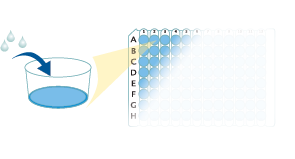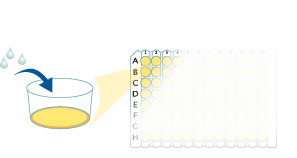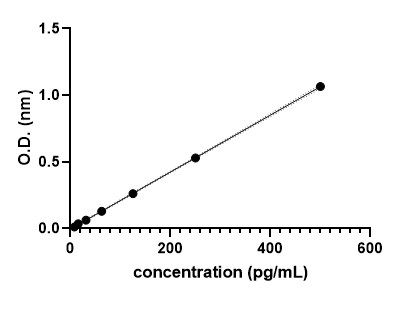Mouse TIM-1/KIM-1/HAVCR Quantikine ELISA Kit Summary
Sample Values
Serum/Plasma/Urine - Samples were evaluated for the presence of mouse TIM-1 in this assay| NSA Strain | Mean of Detectable (pg/mL) | % Detectable | Range (pg/mL) |
| Serum (n=20) | 17.2 | 90 | ND-42.5 |
| EDTA plasma (n=20) | 25.6 | 100 | 7.87-174 |
| Heparin plasma (n=20) | 18.0 | 95 | ND-42.8 |
| Urine (n=20) | 2248 | 100 | 456-8048 |
| Tissue Type | (pg/mL) |
| NSA mouse kidney (1 day) | 1006 |
| NSA mouse kidney (3 days) | 756 |
| Balb/c mouse kidney (2 days) | 1679 |
| C57 mouse kidney (2 days) | 24 |
Product Summary
Precision
Cell Culture Supernates, Serum, EDTA Plasma, Heparin Plasma, Urine
| Intra-Assay Precision | Inter-Assay Precision | |||||
|---|---|---|---|---|---|---|
| Sample | 1 | 2 | 3 | 1 | 2 | 3 |
| n | 20 | 20 | 20 | 20 | 20 | 20 |
| Mean (pg/mL) | 24.2 | 61.8 | 207 | 23.2 | 60 | 190 |
| Standard Deviation | 0.8 | 1.6 | 6.8 | 2.5 | 4.2 | 13.2 |
| CV% | 3.3 | 2.6 | 3.3 | 10.8 | 7 | 6.9 |
Recovery
The recovery of TIM-1 spiked into various matrices was evaluated.
| Sample Type | Average % Recovery | Range % |
|---|---|---|
| Cell Culture Media (n=4) | 100 | 91-106 |
| EDTA Plasma (n=4) | 89 | 88-91 |
| Heparin Plasma (n=4) | 87 | 86-89 |
| Serum (n=4) | 95 | 93-97 |
| Urine (n=4) | 102 | 94-115 |
Linearity
Scientific Data
Product Datasheets
Preparation and Storage
Background: TIM-1/KIM-1/HAVCR
TIM-1 (T cell immunoglobulin and mucin domain 1), also known as KIM-1 and HAVcr1, is expressed on many immune cell types and epithelial cells. It binds to phosphatidylserine (PS), LMIR5/CD300b, TIM-1 (homophilic), TIM-4, IgA, and the glycoproteins of a number of enveloped viruses. Its interaction with PS enables TIM-1 to mediate the phagocytosis and clearance of apoptotic cells. TIM-1 signaling costimulates T cell activation and enhances Th2 cytokine production. TIM-1 serves as a cellular entry receptor for hepatitis A virus, Ebolavirus and Marburgvirus. Polymorphisms are associated with susceptibility to atopy, autoimmunity, and severe hepatitis A virus infection in humans. A soluble form of TIM-1 is elevated in the urine during nephropathy.
Assay Procedure
Refer to the product- Prepare all reagents, standard dilutions, and samples as directed in the product insert.
- Remove excess microplate strips from the plate frame, return them to the foil pouch containing the desiccant pack, and reseal.
- Add 50 µL of Assay Diluent to each well.
- Add 50 µL of Standard, control, or sample to each well. Cover with a plate sealer, and incubate at room temperature for 2 hours on a horizontal orbital microplate shaker.
- Aspirate each well and wash, repeating the process 4 times for a total of 5 washes.
- Add 100 µL of cold Conjugate to each well. Cover with a new plate sealer, and incubate at 2-8 °C for 1 hour on the benchtop.
- Aspirate and wash 5 times.
- Add 100 µL Substrate Solution to each well. Incubate at room temperature for 30 minutes on the benchtop. PROTECT FROM LIGHT.
- Add 100 µL of Stop Solution to each well. Read at 450 nm within 30 minutes. Set wavelength correction to 540 nm or 570 nm.





Citations for Mouse TIM-1/KIM-1/HAVCR Quantikine ELISA Kit
R&D Systems personnel manually curate a database that contains references using R&D Systems products. The data collected includes not only links to publications in PubMed, but also provides information about sample types, species, and experimental conditions.
25
Citations: Showing 1 - 10
Filter your results:
Filter by:
-
Pyruvate kinase M2 regulates mitochondrial homeostasis in cisplatin-induced acute kidney injury
Authors: Xie, W;He, Q;Zhang, Y;Xu, X;Wen, P;Cao, H;Zhou, Y;Luo, J;Yang, J;Jiang, L;
Cell death & disease
Species: Mouse
Sample Types: Urine
-
Mesenchymal Stem Cells Delivered Locally to Ischemia-Reperfused Kidneys via Injectable Hyaluronic Acid Hydrogels Decrease Extracellular Matrix Remodeling 1 Month after Injury in Male Mice
Authors: Han, DS;Erickson, C;Hansen, KC;Kirkbride-Romeo, L;He, Z;Rodell, CB;Soranno, DE;
Cells
Species: Mouse
Sample Types: Urine
-
The VEGF Inhibitor Soluble Fms-like Tyrosine Kinase 1 Does Not Promote AKI-to-CKD Transition
Authors: CCL van Aanhol, A Koudijs, KL Dijkstra, R Wolterbeek, JA Bruijn, C van Kooten, HJ Baelde
International Journal of Molecular Sciences, 2022-08-26;23(17):.
Species: Mouse
Sample Types: Serum
-
Immune-mediated tubule atrophy promotes acute kidney injury to chronic kidney disease transition
Authors: L Xu, J Guo, DG Moledina, LG Cantley
Nature Communications, 2022-08-19;13(1):4892.
Species: Mouse
Sample Types: Serum
-
Effects of Suramin on Polycystic Kidney Disease in a Mouse Model of Polycystin-1 Deficiency
Authors: MY Chang, SH Hsu, LY Ma, LF Chou, CC Hung, YC Tian, CW Yang
International Journal of Molecular Sciences, 2022-07-31;23(15):.
Species: Mouse
Sample Types: Plasma
-
Snapshots of nascent RNA reveal cell- and stimulus- specific responses to acute kidney injury
Authors: TH Shen, J Stauber, K Xu, A Jacunski, N Paragas, M Callahan, R Banlengchi, AD Levitman, B Desanti de, A Beenken, MS Grau, E Mathieu, Q Zhang, Y Li, T Gopal, N Askanase, S Arumugam, S Mohan, PI Good, JS Stevens, F Lin, SK Sia, CS Lin, V D'Agati, K Kiryluk, NP Tatonetti, J Barasch
JCI Insight, 2022-03-22;0(0):.
Species: Mouse
Sample Types: Tissue Homogenates
-
Juzentaihoto improves adenine-induced chronic renal failure in BALB/c mice via suppression of renal fibrosis and inflammation
Authors: S Ito, E Manabe, Y Dai, M Ishihara, T Tsujino
Journal of pharmacological sciences, 2021-10-25;148(1):172-178.
Species: Mouse
Sample Types: Urine
-
DNA-Aptamer Raised against Receptor for Advanced Glycation End Products Improves Survival Rate in Septic Mice
Authors: Y Koga, A Sotokawauc, Y Higashimot, Y Nishino, N Hashizume, T Kakuma, J Akiba, Y Tanaka, T Matsui, M Yagi, SI Yamagishi
Oxidative Medicine and Cellular Longevity, 2021-08-07;2021(0):9932311.
Species: Mouse
Sample Types: Urine
-
MicroRNA?93 inhibits the apoptosis and inflammatory response of tubular epithelial cells via the PTEN/AKT/mTOR pathway in acute kidney injury
Authors: Y Zhan, M Zhu, S Liu, J Lu, Z Ni, H Cai, W Zhang
Molecular Medicine Reports, 2021-07-23;24(3):.
Species: Mouse
Sample Types: Serum
-
CO-Releasing Molecule-2 Prevents Acute Kidney Injury through Suppression of ROS-Fyn-ER Stress Signaling in Mouse Model
Authors: MJ Uddin, J Jeong, ES Pak, H Ha
Oxidative Medicine and Cellular Longevity, 2021-07-06;2021(0):9947772.
Species: Mouse
Sample Types: Plasma
-
Potential Biomarkers in Diagnosis of Renal Acanthamoebiasis
Authors: K Kot, P Kupnicka, O Witulska, A Czepan, NA ?anocha-Ar, AA ?anocha, DI Kosik-Boga
International Journal of Molecular Sciences, 2021-06-19;22(12):.
Species: Mouse
Sample Types: Tissue Homogenates
-
Angiotensin AT2 Receptor is Anti-inflammatory and Reno-Protective in Lipopolysaccharide Mice Model: Role of IL-10
Authors: N Fatima, S Patel, T Hussain
Frontiers in Pharmacology, 2021-04-15;12(0):600163.
Species: Mouse
Sample Types: Tissue Homogenates
-
Inhibition of Src Family Kinases Ameliorates LPS-Induced Acute Kidney Injury and Mitochondrial Dysfunction in Mice
Authors: ES Pak, MJ Uddin, H Ha
Int J Mol Sci, 2020-11-03;21(21):.
Species: Mouse
Sample Types: Plasma
-
Proximal Tubule mTORC1 Is a Central Player in the Pathophysiology of Diabetic Nephropathy and Its Correction by SGLT2 Inhibitors
Authors: A Kogot-Levi, L Hinden, Y Riahi, T Israeli, B Tirosh, E Cerasi, EB Mizrachi, J Tam, O Mosenzon, G Leibowitz
Cell Rep, 2020-07-28;32(4):107954.
Species: Mouse
Sample Types: Urine
-
Pro-inflammatory P2Y14 receptor inhibition protects against ischemic acute kidney injury in mice
Authors: MA Battistone, AC Mendelsohn, RG Spallanzan, AS Allegretti, RN Liberman, J Sesma, S Kalim, SM Wall, JV Bonventre, ER Lazarowski, D Brown, S Breton
J. Clin. Invest., 2020-07-01;0(0):.
Species: Mouse
Sample Types: Serum
-
Distinct Functional Requirements for Podocalyxin in Immature and Mature Podocytes Reveal Mechanisms of Human Kidney Disease
Authors: I Refaeli, MR Hughes, AK Wong, MLZ Bissonnett, CD Roskelley, A Wayne Vogl, SJ Barbour, BS Freedman, KM McNagny
Sci Rep, 2020-06-10;10(1):9419.
Species: Mouse
Sample Types: Urine
-
The C5a/C5aR2 axis promotes renal inflammation and tissue damage
Authors: T Zhang, KY Wu, N Ma, LL Wei, M Garstka, W Zhou, K Li
JCI Insight, 2020-04-09;5(7):.
Species: Mouse
Sample Types: Tissue Lysates
-
The iron chelator Deferasirox causes severe mitochondrial swelling without depolarization due to a specific effect on inner membrane permeability
Authors: EM Gottwald, CD Schuh, P Drücker, D Haenni, A Pearson, S Ghazi, M Bugarski, M Polesel, M Duss, EM Landau, A Kaech, U Ziegler, AKM Lundby, C Lundby, PS Dittrich, AM Hall
Sci Rep, 2020-01-31;10(1):1577.
Species: Mouse
Sample Types: Urine
-
Using Collaborative Cross Mouse Population to Fill Data Gaps in Risk Assessment: A Case Study of Population-Based Analysis of Toxicokinetics and Kidney Toxicodynamics of Tetrachloroethylene
Authors: YS Luo, JA Cichocki, NH Hsieh, L Lewis, FA Wright, DW Threadgill, WA Chiu, I Rusyn
Environ. Health Perspect., 2019-06-27;127(6):67011.
Species: Mouse
Sample Types: Tissue Culture Supernates
-
Immunoglobulin light chains generate proinflammatory and profibrotic kidney injury
Authors: WZ Ying, X Li, S Rangarajan, W Feng, LM Curtis, PW Sanders
J. Clin. Invest., 2019-06-17;129(7):2792-2806.
Species: Mouse
Sample Types: Urine
-
Uncoupling Protein 2 Increases Blood Pressure in DJ -1 Knockout Mice
Authors: C De Miguel, WC Hamrick, R Sedaka, S Jagarlamud, LD Asico, PA Jose, S Cuevas
J Am Heart Assoc, 2019-05-07;8(9):e011856.
Species: Mouse
Sample Types: Urine
-
Disruption of renal arginine metabolism promotes kidney injury in hepatorenal syndrome
Authors: ZV Varga, K Erdelyi, J Paloczi, R Cinar, ZK Zsengeller, T Jourdan, C Matyas, NT Balazs, A Guillot, X Xiang, A Mehal, G Hasko, IE Stillman, S Rosen, B Gao, G Kunos, P Pacher
Hepatology, 2018-10-01;0(0):.
Species: Mouse
Sample Types: Serum
-
Ameliorative Effect of Daidzein on Cisplatin-Induced Nephrotoxicity in Mice via Modulation of Inflammation, Oxidative Stress, and Cell Death
Authors: H Meng, G Fu, J Shen, K Shen, Z Xu, Y Wang, B Jin, H Pan
Oxid Med Cell Longev, 2017-08-02;2017(0):3140680.
Species: Mouse
Sample Types: Urine
-
Human Alpha-1-Antitrypsin (hAAT) therapy reduces renal dysfunction and acute tubular necrosis in a murine model of bilateral kidney ischemia-reperfusion injury
Authors: N Maicas, J van der Vl, J Bublitz, S Florquin, M Bakker-van, CA Dinarello, V Verweij, R Masereeuw, LA Joosten, LB Hilbrands
PLoS ONE, 2017-02-24;12(2):e0168981.
Species: Mouse
Sample Types: Plasma
-
Senescence marker protein-30/gluconolactonase deficiency exacerbates diabetic nephropathy through tubular injury in a mouse model of type 1 diabetes.
Authors: Okada H, Senmaru T, Fukui M, Kondo Y, Ishigami A, Maruyama N, Obayashi H, Yamazaki M, Nakamura N, Hasegawa G
J Diabetes Investig, 2014-07-07;6(1):35-43.
Species: Mouse
Sample Types: Urine
FAQs
No product specific FAQs exist for this product, however you may
View all ELISA FAQsReviews for Mouse TIM-1/KIM-1/HAVCR Quantikine ELISA Kit
Average Rating: 4.5 (Based on 2 Reviews)
Have you used Mouse TIM-1/KIM-1/HAVCR Quantikine ELISA Kit?
Submit a review and receive an Amazon gift card.
$25/€18/£15/$25CAN/¥75 Yuan/¥2500 Yen for a review with an image
$10/€7/£6/$10 CAD/¥70 Yuan/¥1110 Yen for a review without an image
Filter by:





